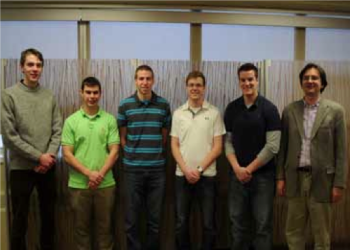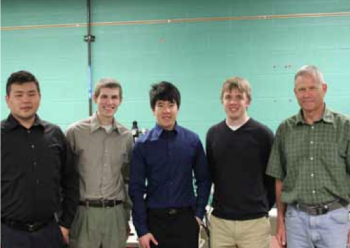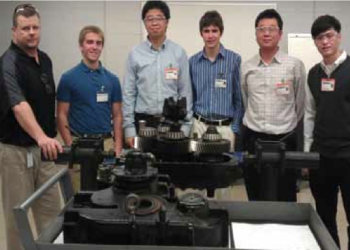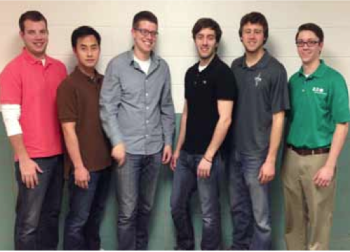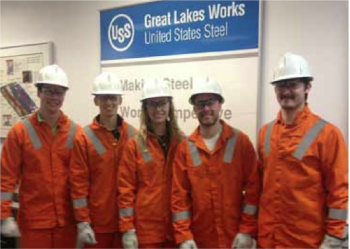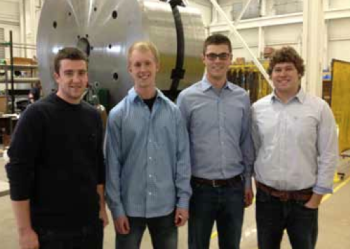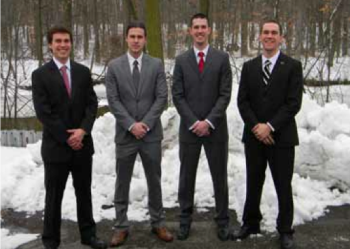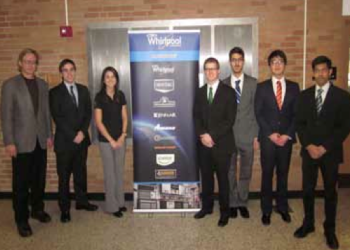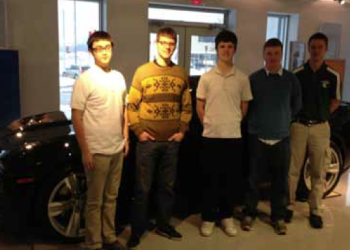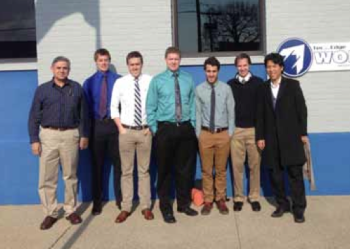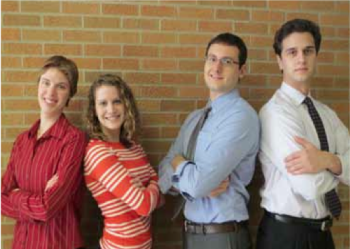Mechanical Engineering
Projects
One goal of the MSU Mechanical Engineering Program is to educate engineers who are prepared to lead, create, and innovate as their professional or graduate careers evolve. The Mechanical Engineering Design Program is the key element of the curriculum that supports this goal. There are five required design courses in the program which provide our students with eight hands-on, team-based, ‘design, test and build’ projects, and numerous opportunities to practice and refine their written, oral, poster, and video presentation skills. The Design Program in Mechanical Engineering has attracted national recognition on many occasions and helps to distinguish the ME program as one of the best in the country.
For information on becoming a project sponsor, please contact Mike Colucci.
Lansing School District and Consumer’s Energy: Solar Heater for Educational Demonstration
 Consumers Energy is a Michigan-based utility company that provides gas and electrical energy services throughout the state to domestic and industrial consumers. The Consumers Energy Foundation regularly sponsors projects that benefit local school districts and, in partnership with Lansing School District, is interested in developing an alternative-energy system for heating a
Consumers Energy is a Michigan-based utility company that provides gas and electrical energy services throughout the state to domestic and industrial consumers. The Consumers Energy Foundation regularly sponsors projects that benefit local school districts and, in partnership with Lansing School District, is interested in developing an alternative-energy system for heating a  vermicomposting bin, which can be used for instructional purposes.
vermicomposting bin, which can be used for instructional purposes.
Vermicomposting is a process in which worms recycle decomposed organic materials into a rich soil known as compost. Although worms can survive freezing temperatures, they cannot compost as efficiently in winter and so a heating system is required to allow them to compost year round. The team is designing and building a heater powered with photovoltaic solar panels to provide this heat transfer, and will demonstrate its composting abilities to students.
Meritor, Inc.: Design of an Air Chamber Bracket Assembly
 Meritor, Inc. is a leading global supplier of a broad range of axle, brake, and suspension systems to both original equipment manufacturers and to aftermarket vendors for the transportation and industrial sectors. The brake systems on heavy-duty vehicles are driven by compressed air and one particular component–the air chamber–converts the air pressure into the force used to activate the brakes. Meritor Heavy Vehicle Braking Systems is interested in redesigning an air chamber bracket assembly that is currently in production. This redesign is intended to benefit Meritor by reducing the weight of the current assembly with minimal added cost. It also provides an opportunity to study thoroughly the current bracket design and its limitations, and to propose ways of reducing mechanical fractures in these components.
Meritor, Inc. is a leading global supplier of a broad range of axle, brake, and suspension systems to both original equipment manufacturers and to aftermarket vendors for the transportation and industrial sectors. The brake systems on heavy-duty vehicles are driven by compressed air and one particular component–the air chamber–converts the air pressure into the force used to activate the brakes. Meritor Heavy Vehicle Braking Systems is interested in redesigning an air chamber bracket assembly that is currently in production. This redesign is intended to benefit Meritor by reducing the weight of the current assembly with minimal added cost. It also provides an opportunity to study thoroughly the current bracket design and its limitations, and to propose ways of reducing mechanical fractures in these components.
The redesigned assembly should weigh 20% less and cost no more than $5 more than the present model. The new lighter design should maintain the stiffness and bending of the current product, and must mesh correctly with the surrounding parts to perform properly within the heavy-vehicle braking system.
The design team plans to make computer-aided design models of the current bracket assembly and perform finite element analysis tests to determine which areas of the bracket can be made lighter without impairing their function. It also plans to carry out physical vibrations tests of previously fractured parts to identify points of potential weakness. The team will then build a plastic prototype of its new air chamber bracket design.
Meritor, Inc.: Electric Shift Mechanisms for Transfer Cases
 Meritor is a global leader in providing drivetrain- mobility and braking-solution products for manufacturers and after-market suppliers of trucks, trailers and specialty vehicles in the industrial and transportation sectors. One such product is the transfer case, which takes power from an engine’s transmission and drives both the front and back axles. It can power either the rear axle, as a two-wheel drive, or both the front and rear axles, as a four-wheel drive. Transfer cases can also be used to shift from high to low rotational speeds, to increase the torque provided to the axles. Meritor’s current line of transfer cases uses pneumatic shifting between speed ranges. However, many medium-duty vehicles are not equipped with the compressed- air systems required for pneumatic shifting. Therefore there is a need for an electric shifting system. Meritor has designed a potential electrical shift system that comprises a motor- controlled sector cam that shifts two separate forks. One of the forks changes the drive between high, low, and neutral positions while the other switches the drive between two- wheel and four-wheel drive.
Meritor is a global leader in providing drivetrain- mobility and braking-solution products for manufacturers and after-market suppliers of trucks, trailers and specialty vehicles in the industrial and transportation sectors. One such product is the transfer case, which takes power from an engine’s transmission and drives both the front and back axles. It can power either the rear axle, as a two-wheel drive, or both the front and rear axles, as a four-wheel drive. Transfer cases can also be used to shift from high to low rotational speeds, to increase the torque provided to the axles. Meritor’s current line of transfer cases uses pneumatic shifting between speed ranges. However, many medium-duty vehicles are not equipped with the compressed- air systems required for pneumatic shifting. Therefore there is a need for an electric shifting system. Meritor has designed a potential electrical shift system that comprises a motor- controlled sector cam that shifts two separate forks. One of the forks changes the drive between high, low, and neutral positions while the other switches the drive between two- wheel and four-wheel drive.
The objective of this project is to analyze and optimize Meritor’s proposed electrical shift system. The team plans to create an analysis model using CAD software, with which the torque needed to move forks to each position and the stresses of each component are to be calculated. It then plans to optimize the system design to minimize the shifting torque required, and to maximize the performance life of the system through the choice of springs and shifting speeds.
Eaton Corporation: Composite Tube Manufacturing Process Design
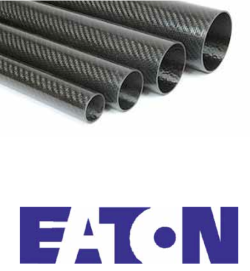 Eaton Corporation is a global technology company that currently employs over 100,000 people in 150 different countries. Eaton Aerospace is one of its divisions and is an industry- leader in power management applications in the field of aerospace, specializing in fuel coupling and ducting components for all types of aircraft. It is interested in developing the next generation of high-performance, sustainable, and economical aircraft fuel systems. To accomplish this goal, Eaton proposes to manufacture ducting and hoses from lightweight and high-temperature-resistant materials such as composites.
Eaton Corporation is a global technology company that currently employs over 100,000 people in 150 different countries. Eaton Aerospace is one of its divisions and is an industry- leader in power management applications in the field of aerospace, specializing in fuel coupling and ducting components for all types of aircraft. It is interested in developing the next generation of high-performance, sustainable, and economical aircraft fuel systems. To accomplish this goal, Eaton proposes to manufacture ducting and hoses from lightweight and high-temperature-resistant materials such as composites.
The focus of this project is on the proposed use of composite-material piping for fluids in aircraft and the need to produce non-metallic pipes of sizes and curvatures that conform with a wide range of operating constraints. The MSU design team’s goal is to design and develop an apparatus with a removable center form to produce these types of composite tubes, in a way that reduces cost and production time relative to current manufacturing methods. The design team then plans to produce a prototype of the composite forming device which, if successful, would be an integral part of Eaton’s manufacturing technologies.
U.S. Steel Corporation: Design go a Mold Flux Feeder for a Steel Caster
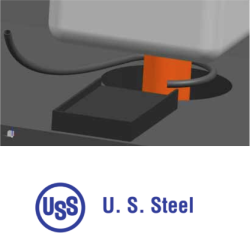 United States Steel Corporation is the largest integrated steel producer headquartered in the United States, with a global capacity of 29 million tons per year. The key customers to which U.S. Steel provides its products are automobile, appliance, container, industrial machinery, construction, and oil and gas industries.
United States Steel Corporation is the largest integrated steel producer headquartered in the United States, with a global capacity of 29 million tons per year. The key customers to which U.S. Steel provides its products are automobile, appliance, container, industrial machinery, construction, and oil and gas industries.
U.S. Steel wishes to design an automatic mold-flux feeder for their rounds caster located in Fairfield, AL, which produces steel in four parallel ‘strands.’ Mold flux is a metallic aggregate that is distributed over the surface of molten steel during processing, where it melts and spreads to: i) serve as a lubricant between the mold and the cooling shell; ii) prevent oxidation of the liquid steel to maintain its purity; and iii) serve as an insulator to facilitate uniform heat transfer throughout the cooling strand. If the mold flux is not distributed uniformly, breakouts–ruptures of the outer steel shell and releases of molten steel from within the core of the cooling bloom–occur, resulting in lost production, increased maintenance costs, a lower- quality steel product, and safety concerns.
The objective of the automatic mold-flux feeder is to evenly distribute flux and maintain it at a constant level on the top surface of the mold; it is currently distributed manually, by the shovelful. The MSU team is exploring mechanical and pressure-driven systems as possible design solutions. Computer-aided models will be used to supplement results from experimental prototypes to create an optimal design.
Ingersoll Rand: Improved Assembly of HVAC Equipment
 The Trane Division of Ingersoll Rand has long focused on innovation in heating and air conditioning systems for domestic and commercial use, and is currently one of the world’s leading manufacturers. Trane caters to both residential and commercial heating, ventilation and air-conditioning (HVAC) system needs, and through its reputation for reliable, high quality products has gained 40% of the commercial systems market share. Commercial HVAC systems are custom designed to meet the customers’ specifications and are constructed as HVAC hardware enclosed by laminated, foam-filled metal panels. These panels are large and heavy, and are manufactured in a range of sizes from different gauges of steel. They are currently transported manually from conveyor belts to carts during the assembly of an HVAC system. The need for employees to lift these panels, which often weigh from 50 to 100 pounds, repetitively has been identified as a potential health risk, and Trane are exploring ways of eliminating manual lifting while increasing productivity.
The Trane Division of Ingersoll Rand has long focused on innovation in heating and air conditioning systems for domestic and commercial use, and is currently one of the world’s leading manufacturers. Trane caters to both residential and commercial heating, ventilation and air-conditioning (HVAC) system needs, and through its reputation for reliable, high quality products has gained 40% of the commercial systems market share. Commercial HVAC systems are custom designed to meet the customers’ specifications and are constructed as HVAC hardware enclosed by laminated, foam-filled metal panels. These panels are large and heavy, and are manufactured in a range of sizes from different gauges of steel. They are currently transported manually from conveyor belts to carts during the assembly of an HVAC system. The need for employees to lift these panels, which often weigh from 50 to 100 pounds, repetitively has been identified as a potential health risk, and Trane are exploring ways of eliminating manual lifting while increasing productivity.
The MSU design team plans to carry out an ergonomic assessment of the process of transporting panels from the end of the manufacturing assembly line to the carts. The team also learned that, in the past, pneumatic suction lifts had been used to move these panels, but that facility employees had found it more productive to manually lift and sort the panels onto the carts. The goal of this team is therefore to provide a design solution for panel transportation that both reduces health risks and improves productivity.
Whirlpool Corporation: Basket Design for a Top-Load Washing Machine
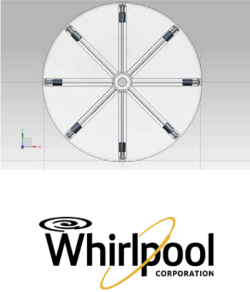 Whirlpool Corporation is the world’s leading manufacturer and marketer of home appliances, with its headquarters in Benton Harbor, Michigan. Along with the well-known Whirlpool brand, the company has also acquired Maytag, KitchenAid, Amana and other home appliance companies and offers an extensive product line of appliances for markets throughout the world.
Whirlpool Corporation is the world’s leading manufacturer and marketer of home appliances, with its headquarters in Benton Harbor, Michigan. Along with the well-known Whirlpool brand, the company has also acquired Maytag, KitchenAid, Amana and other home appliance companies and offers an extensive product line of appliances for markets throughout the world.
The washing machine engineers at Whirlpool have asked the MSU team to re-design and analyze of one of its most successful high-efficiency top-load washing machine baskets, which is currently used in the Maytag Bravos X machine. The present design features a base of conical shape that provides a rigid connection between the drive shaft of the motor and the wash-basket cylinder. The objective of this project is to design a more compact base that provides the same connection function but allows a greater volume within the basket for washing. A base with a lower profile also reduces the volume of unused water that is trapped beneath the base during wash cycles and improves washing efficiency. The proposed design must meet and/or exceed the safety requirements set forth by Whirlpool Corporation in the areas of extreme stress and fatigue loading conditions. The MSU team plans to explore various geometric designs, and expects to make extensive use of finite element analyses in finding an innovative but reliable design solution.
Whirlpool Corporation: Heat Exchanger Design for a Top-Loader Washer
 Whirlpool Corporation is the world’s largest appliance manufacturer and has its headquarters in Benton Harbor, Michigan. Whirlpool has a large global presence and sells many products in more than 170 countries. In its efforts to improve appliance efficiency, Whirlpool is interested in reducing the energy consumption of its top-load washers.
Whirlpool Corporation is the world’s largest appliance manufacturer and has its headquarters in Benton Harbor, Michigan. Whirlpool has a large global presence and sells many products in more than 170 countries. In its efforts to improve appliance efficiency, Whirlpool is interested in reducing the energy consumption of its top-load washers.
One way of improving the efficiency of washers is by regenerative heat transfer, extracting the heat generated by the motor during the wash cycle and using it to raise the temperature of the wash water. This process reduces the requirement for hot water from the consumer’s home and permits better machine performance. It may also allow more cost-effective motors to be used in large capacity washers.
To explore this energy-saving concept, the MSU team will design and analyze regenerative heat transfer systems that have the potential to improve overall washer efficiency. An optimal design will then be selected and a prototype will be built and tested for functionality and reliability, then delivered to Whirlpool for further evaluation.
Stryker Corporation: Hospital Bed Extender Design and Optimization
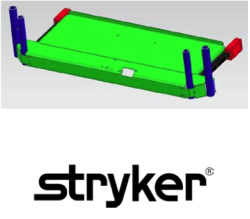 Stryker Corporation is a medical equipment manufacturer based in Kalamazoo which develops surgical and imaging technologies, and produces patient handling and medical emergency devices. One particular device it manufactures is a hospital bed, which must accommodate patients of different physiques while allowing medical professionals access to the patient for treatment. In contrast to conventional beds, hospital beds are carefully designed and engineered structures that are rugged but adjustable, and play a critical role in the timely recovery of patients. Hospital beds are typically manufactured in a standard size, but with a bed extension system available to accommodate tall patients.
Stryker Corporation is a medical equipment manufacturer based in Kalamazoo which develops surgical and imaging technologies, and produces patient handling and medical emergency devices. One particular device it manufactures is a hospital bed, which must accommodate patients of different physiques while allowing medical professionals access to the patient for treatment. In contrast to conventional beds, hospital beds are carefully designed and engineered structures that are rugged but adjustable, and play a critical role in the timely recovery of patients. Hospital beds are typically manufactured in a standard size, but with a bed extension system available to accommodate tall patients.
The objective of this project is to redesign an existing bed extender and optimize it for use in hospitals around the country. Problems that have been identified with the current design include: i) the awkwardness of extending the structure; and ii) the stability of the extension, which can wobble. This design exercise will focus on a mechanism for extending the bed, that can be activated with a single motion of one hand, and a more rigid structure, with a minimized overall cost and weight. The bed extender must be able to be positioned in either an extended or a retracted state, to allow for easier storage and maneuverability, and must withstand the rigors of a hospital environment. A successfully redesigned bed extender will improve the capabilities of existing beds and the recovery conditions of patients.
Robert Bosch, LLC: Gas Response Test System for Exhaust Sensors
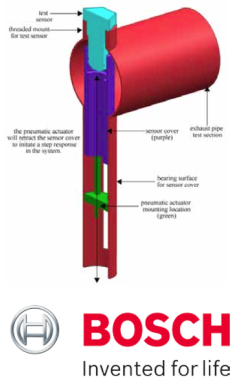 Robert Bosch LLC is a leading global supplier of technology and services to a range of industries that includes automotive, industrial, consumer goods, and building technologies. It targets much of its automotive technology at increased fuel economy and reduced exhaust- gas emissions, including the design and production of oxygen and NOx sensors for engine after-treatment systems. Currently, Bosch manufactures exhaust gas sensors to monitor and control the emissions of automobile engines, each of which must be tested for accuracy and reliability. The Diesel engine group at Robert Bosch LLC is interested in a more accurate and consistent method of testing and evaluating the performance of its NOx and O2 sensors before distributing them to customers.
Robert Bosch LLC is a leading global supplier of technology and services to a range of industries that includes automotive, industrial, consumer goods, and building technologies. It targets much of its automotive technology at increased fuel economy and reduced exhaust- gas emissions, including the design and production of oxygen and NOx sensors for engine after-treatment systems. Currently, Bosch manufactures exhaust gas sensors to monitor and control the emissions of automobile engines, each of which must be tested for accuracy and reliability. The Diesel engine group at Robert Bosch LLC is interested in a more accurate and consistent method of testing and evaluating the performance of its NOx and O2 sensors before distributing them to customers.
In its Farmington Hills facility, Bosch currently tests the performance of its emissions sensors on a test bench. However, these tests do not reproduce the conditions of the exhaust flow in an automobile and a more representative bench test is required. The goal of the MSU design team is to design a test bench for emissions sensors that creates a step response to test more accurately and consistently O2 and NOx sensors. To solve this problem, it plans to develop a mechanical system inside an exhaust pipe that will be able to quickly cover and remove the sensor, in between 100 and 200 milliseconds, without disrupting the exhaust-gas flow. Since the gas flow in this bench test contains harmful emissions, it is essential that the test system has no leaks. The final project goal is to deliver to Bosch a working prototype to test its emissions sensors.
Ford Motor Company: Design of a Steering Column Gap-Hider System
 Ford Motor Company was founded 110 years ago in southeastern Michigan and is now one of the world’s largest automobile manufacturers. Its products are both produced and sold globally. An important aspect of automotive design is the fit and finish of automobile interiors, which are a key factor in showroom sales and in the long-term satisfaction of the customer. Ford is especially interested in improving one component in the interior design of its current Lincoln models: the ‘gap-hider’ which covers the top of the steering column and connects to the dashboard. The gap-hider’s function and purpose is to cover the internal components of the steering column, as well as to perform as an aesthetically pleasing interior piece.
Ford Motor Company was founded 110 years ago in southeastern Michigan and is now one of the world’s largest automobile manufacturers. Its products are both produced and sold globally. An important aspect of automotive design is the fit and finish of automobile interiors, which are a key factor in showroom sales and in the long-term satisfaction of the customer. Ford is especially interested in improving one component in the interior design of its current Lincoln models: the ‘gap-hider’ which covers the top of the steering column and connects to the dashboard. The gap-hider’s function and purpose is to cover the internal components of the steering column, as well as to perform as an aesthetically pleasing interior piece.
One problem with the current gap-hider design is that it wrinkles during telescoping and tilting of the steering wheel. This wrinkling is visually unattractive and detracts from the luxury of the Lincoln brand and of the interior of the vehicle. With repeated motion of the steering column, the gap-hider material can deteriorate and lose its integrity. The MSU team is currently considering two different design approaches: implementing a new material for the gap-hider; and attaching the material to the steering column interface in a different way. Prototypes of each design solution will be tested to determine the optimal solution to this problem.
General Motors Foundation: Design of Active and Passive Cabin Ventilation
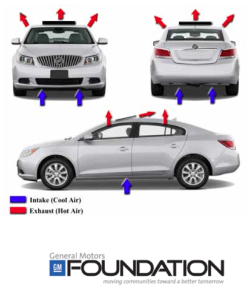 General Motors Corporation is a multinational automotive manufacturer with headquarters in Detroit, MI and is one of the largest automotive companies in the world. Its vehicles manufactured for the US market must soon be in compliance with the Environmental Protection Agency’s more stringent 2017 fuel economy standards, which regulate exhaust- gas emissions of the ‘greenhouse gas’ carbon dioxide. General Motors is interested in exploring ways of improving fuel economy by reducing the need to use air-conditioning systems in its automobiles, which also translates to carbon dioxide ‘credits.’
General Motors Corporation is a multinational automotive manufacturer with headquarters in Detroit, MI and is one of the largest automotive companies in the world. Its vehicles manufactured for the US market must soon be in compliance with the Environmental Protection Agency’s more stringent 2017 fuel economy standards, which regulate exhaust- gas emissions of the ‘greenhouse gas’ carbon dioxide. General Motors is interested in exploring ways of improving fuel economy by reducing the need to use air-conditioning systems in its automobiles, which also translates to carbon dioxide ‘credits.’
The objective of this project is to explore concepts for active (i.e. fan-driven) and passive cabin ventilation systems that reduce the interior temperature of the vehicle when it is parked in direct sunlight. The MSU design team plans to investigate ways in which ducts and other devices can be used to move hot air from the cabin to the vehicle’s exterior by either natural or forced convection, thereby reducing the need for engine-driven air-conditioning. General Motors has provided a vehicle for the team to use to develop and demonstrate their most effective design solution.
General Electric Healthcare: Design of a Mobile Breast Imaging Unit
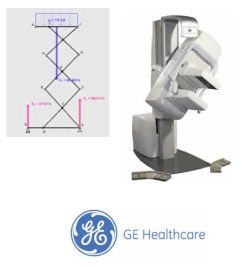 GE Healthcare is a division of the General Electric Company, one of the world’s leaders in the development and manufacturing of a wide range of electrical and mechanical engineering products. GE Healthcare currently manufactures a device known as the NM750B Molecular Breast Imaging Unit, which is used in hospitals worldwide. The unit performs functions similar to those of magnetic resonance imaging (MRI) devices used for the detection of breast cancer. However, it is a significant improvement on traditional MRI and x-ray devices as it is smaller and lighter, and reduces patient discomfort during the scan. The present unit is too large and too heavy to be transported by van or relocated manually within hospitals. The MSU design team has been assigned the task of redesigning and optimizing the NM750B for improved mobility, so that it can be easily transported by van in the field, or moved from ward to ward in a hospital so that more patients can benefit from scans.
GE Healthcare is a division of the General Electric Company, one of the world’s leaders in the development and manufacturing of a wide range of electrical and mechanical engineering products. GE Healthcare currently manufactures a device known as the NM750B Molecular Breast Imaging Unit, which is used in hospitals worldwide. The unit performs functions similar to those of magnetic resonance imaging (MRI) devices used for the detection of breast cancer. However, it is a significant improvement on traditional MRI and x-ray devices as it is smaller and lighter, and reduces patient discomfort during the scan. The present unit is too large and too heavy to be transported by van or relocated manually within hospitals. The MSU design team has been assigned the task of redesigning and optimizing the NM750B for improved mobility, so that it can be easily transported by van in the field, or moved from ward to ward in a hospital so that more patients can benefit from scans.
The primary design goals of this project are to decrease the overall dimensions and weight of the unit so that it can be moved by hospital staff, without making any changes to the scanning, computing, and electrical interface equipment. The design team plans to build a prototype based on their redesign, which can be used by GE as a basis for refined redesigns and for use at trade shows and symposia.
U.S. Air Force Research Laboratory: Solid State Aerial Surveillance Gimbal Design
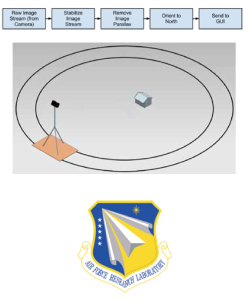 The US Air Force uses aerial surveillance for a variety of military and humanitarian missions. However, aerial surveillance systems are limited by the way in which images are captured from airborne vehicles. Such systems typically include a camera that moves within a mount (a ‘mechanical gimbal’) as the vehicle flies above its target. The mount holds the camera steady so that a clear image can be produced. The gimbals are complex, heavy, and cost approximately one million dollars, so a less expensive equivalent is desirable. One alternative that has been proposed is a ‘solid-state’ gimbal that is static with respect to the aircraft. The long-term goal of this project is to develop an active optical targeting system that can be deployed using images produced by such a gimbal mounted in an unmanned aerial vehicle (UAV or “drone”), flying in a circular path above an active or potential battlespace.
The US Air Force uses aerial surveillance for a variety of military and humanitarian missions. However, aerial surveillance systems are limited by the way in which images are captured from airborne vehicles. Such systems typically include a camera that moves within a mount (a ‘mechanical gimbal’) as the vehicle flies above its target. The mount holds the camera steady so that a clear image can be produced. The gimbals are complex, heavy, and cost approximately one million dollars, so a less expensive equivalent is desirable. One alternative that has been proposed is a ‘solid-state’ gimbal that is static with respect to the aircraft. The long-term goal of this project is to develop an active optical targeting system that can be deployed using images produced by such a gimbal mounted in an unmanned aerial vehicle (UAV or “drone”), flying in a circular path above an active or potential battlespace.
The MSU design team’s challenge is to create an image processing algorithm that allows the images produced by the ‘solid state gimbal’ to be used in the battlefield. The objective is to stream live images at three frames per second, while simultaneously stabilizing the images for display. The images are logged so that the user can analyze data and information regarding action at an earlier moment in time. To solve the problem, the team plans to: develop an algorithm that stabilizes a series of images; create a graphical user interface (GUI) to allow a user to interact with the images; build a test rig to demonstrate the algorithm’s abilities; and secure the use of a powerful camera to create the raw image stream.
Dow Chemical Company: Fabrication of a Reverse Osmosis Filter
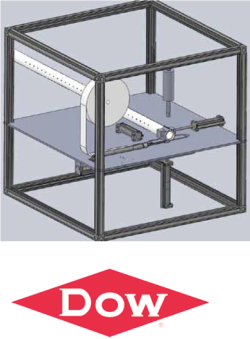 The FilmTec Corporation, a subsidiary of Dow Chemical’s Water & Process Solutions that was acquired in 1985, has helped Dow become the global leader in the manufacturing and supply of reverse osmosis and nano-filtration products. FilmTec’s current method of manufacturing reverse osmosis filters requires wrapping the filter element onto a plastic tube coated in polyurethane glue, trimming the ends of the filter to size, and securing the filter element by placing caps on the tube’s ends. The trimmed portions of the filter element cannot be removed if there is glue on the tube beneath that section, so a removable protective film layer is used to keep glue from the tube ends. Currently, employees wrap a Teflon film strip around each tube end manually, and secure the film with packaging tape. This manual application method is time consuming and yields results the qualities of which vary according to the dexterity and attentiveness of the assembler.
The FilmTec Corporation, a subsidiary of Dow Chemical’s Water & Process Solutions that was acquired in 1985, has helped Dow become the global leader in the manufacturing and supply of reverse osmosis and nano-filtration products. FilmTec’s current method of manufacturing reverse osmosis filters requires wrapping the filter element onto a plastic tube coated in polyurethane glue, trimming the ends of the filter to size, and securing the filter element by placing caps on the tube’s ends. The trimmed portions of the filter element cannot be removed if there is glue on the tube beneath that section, so a removable protective film layer is used to keep glue from the tube ends. Currently, employees wrap a Teflon film strip around each tube end manually, and secure the film with packaging tape. This manual application method is time consuming and yields results the qualities of which vary according to the dexterity and attentiveness of the assembler.
The primary goal of this project is to design and produce a fixture that will automatically wrap, tension, and then secure the film strip around the tube in an efficient and highly repeatable manner. A secondary goal is to select a new material and attachment method if it is considered advantageous for automation of this process. A successful outcome of the project would be that a reverse osmosis filter could be assembled with Dow’s employees only having to manually insert and remove the tube from the fixture.
Union Pacific Company: Improved Design of Air Hose Connections
 Union Pacific Railroad has been providing high- quality freight services since its establishment in 1862. Today, it owns the nation’s largest railroad network consisting of 31,900 miles of track. As a company engaged in ‘Building America,’ it focuses on providing safe and high-quality service for its customers.
Union Pacific Railroad has been providing high- quality freight services since its establishment in 1862. Today, it owns the nation’s largest railroad network consisting of 31,900 miles of track. As a company engaged in ‘Building America,’ it focuses on providing safe and high-quality service for its customers.
A current concern of Union Pacific is the accidental separation of F-type glad-hand air-hose connections, which occurs occasionally during train operations. The function of the glad-hand connection is to allow pressurization of the braking system along the length of the train. The braking system of the train is designed so that when air pressure is lost through an accidental disconnection, the emergency brakes are applied, which can cause significant train delays and possible derailments; these events result in late arrivals/ deliveries and potential damage to goods. While the use of double-wide gaskets and the implementation of part-life regulations have reduced the frequency of disconnections, they remain an area of concern for Union Pacific.
The goal of this project is to further reduce or eliminate these accidental disconnections by developing: i) a more reliable glad-hand design; or ii) a stricter criterion for the maximum glad-hand lifespan. Benchmarks for this maximum lifespan criterion will be established by measuring deviations in pull-apart force of glad-hands that have undergone varying levels of degradation through use. Reaching these goals should improve the reliability of Union Pacific’s services.
Alcoa, Inc: Bean Seed Dryer for Central American Farmers
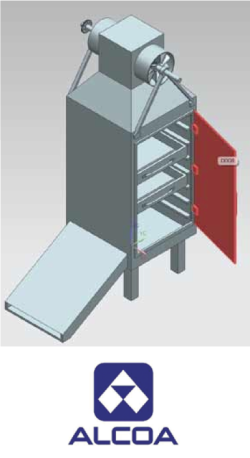 Alcoa Inc. is the world’s leading producer of aluminum and alumina. Each year, it sponsors a design project targeted at international development; this year’s project addresses the seed drying needs of Latin American farmers.
Alcoa Inc. is the world’s leading producer of aluminum and alumina. Each year, it sponsors a design project targeted at international development; this year’s project addresses the seed drying needs of Latin American farmers.
Farmers in the rural farm lands of Central and South America specialize in the cultivation of beans for subsistence and for regional commercial sale. Many of their farming and processing methods are basic and, by US standards, inefficient. A major challenge to these farmers is to dry their beans sufficiently once they have been harvested from the fields. Drying the beans serves the purposes of: prolonging their storage life; and resisting their attack by pests during storage. Current drying methods are much slower than the rate of harvesting. As a result, farmers risk losing their harvest through rain damage while drying, or through rotting if left in the fields. The objective of this project is to design a device or drying procedure that can accelerate the drying process for these farmers, and so raise the quality of their produce.
Prior to developing solutions, the MSU team has engaged the expert assistance of Dr. Luis Flores of MSU’s Institute of International Agriculture, who has visited these rural farming regions and is a local expert on their farming techniques and customs. The team will use his knowledge to propose and develop a design solution for a bean seed dryer that uses technology and materials appropriate to these regions, and suited to the farmers’ customs.
